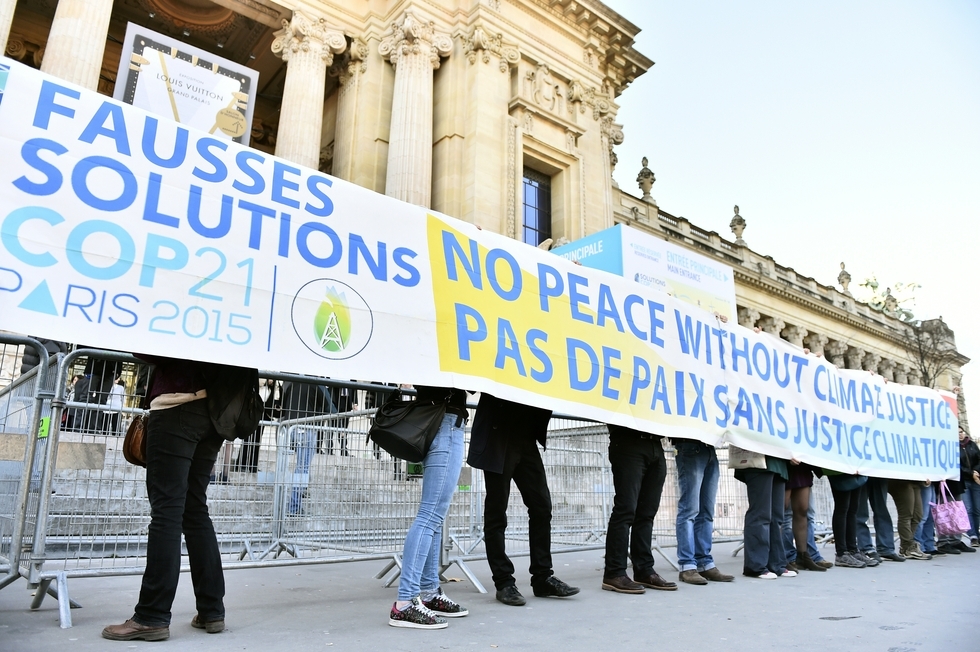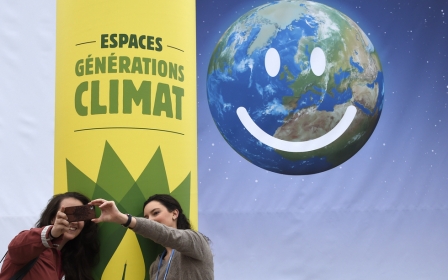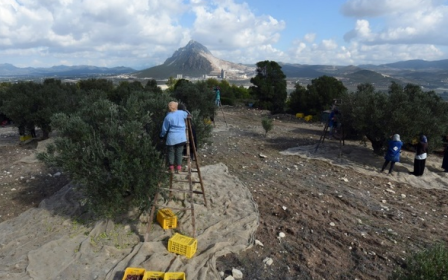Paris climate negotiations won’t stop the planet burning

The much-vaunted COP21 negotiations in Paris are, despite the claims of world leaders, dead on arrival.
Emissions reductions targets are not up for discussion. Those pledges are already on the table, having been put forward voluntarily by each country.
Government negotiators in Paris are instead looking at banal details of how and when countries should commit to improving their voluntary pledges, and ensuring "transparency" and "accountability".
Catastrophe?
But current emissions pledges already guarantee disaster. A report by the United Nations Framework Convention on Climate Change (UNFCC) released in October calculated that: “Compared with the emission levels consistent with the least-cost 2 °C scenarios, aggregate GHG emission levels resulting from the INDCs [intended nationally determined contributions] are expected to be higher by 8.7 (4.7–13.0) Gt CO2 eq (19 percent, range 10–29 percent) in 2025 and by 15.1 (11.1–21.7) Gt CO2 eq (35 per cent, range 26–59 percent) in 2030.”
The targets set in stone before Paris, in other words, are already insufficient to avoid a global average temperature rise of 2 degrees Celsius – accepted by policymakers as the safe limit beyond which the planet enters the realm of dangerous climate change.
According to the UNFCC report, “much greater emission reductions effort than those associated with the INDCs will be required in the period after 2025 and 2030 to hold the temperature rise below 2 °C above pre-industrial levels.”
But pushing forward even more ambitious reductions for the post-2030 era is “not realistic anymore,” according to Tommi Ekholm, senior scientist at VTT Technical Research Centre of Finland, which has just undertaken a comprehensive analysis of emissions targets from 159 countries. “Therefore it is critically important to make the current emission targets for 2030 more ambitious.”
Writing in Nature four years ago, one team of scientists concluded that we could breach the two degree danger zone shortly after mid-century, after 2060.
Two decades to go
But the more scientists learn, the more they realise we keep underestimating the risks. Last year, an analysis in Scientific American by Professor Michael Mann of Pennsylvania State University explained that new research showed the two degree danger zone could be breached at our present rate of emissions within just 20 years.
This means limiting global atmospheric carbon dioxide (CO2) concentrations to around 405 parts per million (ppm).
Even this, Mann explained, is based on “a conservative definition of climate sensitivity that considers only the so-called fast feedbacks in the climate system, such as changes in clouds, water vapour and melting sea ice. Some climate scientists, including James E. Hansen, former head of the NASA Goddard Institute for Space Studies, say we must also consider slower feedbacks such as changes in the continental ice sheets.”
That implies that a safe level of atmospheric CO2 is actually less than 350 ppm.
“We are well on our way to surpassing these limits,” wrote Mann. “In 2013 atmospheric CO2 briefly reached 400 ppm for the first time in recorded history – and perhaps for the first time in millions of years, according to geologic evidence. To avoid breaching the 405-ppm threshold, fossil-fuel burning would essentially have to cease immediately.”
Terraforming the Earth
Teetering on the edge of the 400 ppm threshold as we are now may well already mean a “radically-altered” planet in the long-term, according to geoscientist Jeff Severinghaus of the Scripps Institute of Oceanography.
During the Pliocene between three and five million years ago, CO2 levels reached around 415 parts per million (ppm). At this time, global average temperatures were around 3-4 C higher, and sea levels between 16 and 131 feet higher than today.
An earlier UNFCC report summarising the conclusions of 70 scientific experts noted that avoiding dangerous climate change requires “a fundamental transformation of the energy system and global GHG emission levels towards zero by 2100.” The report emphasised:
“Limiting global warming to below 2C necessitates a radical transition (deep decarbonisation now and going forward), not merely a fine tuning of current trends.”
Yet deep carbonisation is not even being mentioned in Paris.
“One of the key things… that is not being discussed at the negotiations at all is to put a limit to fossil fuel extractions,” said Pablo Solon, former chief climate negotiator for the Bolivian government, and a former ambassador the UN. “There is not one single leader, one single country that has put text to be negotiated that says you have to leave 80 percent of fossil fuels under the ground. And if you don’t leave fossil fuels under the ground, how are you going to limit greenhouse gas emissions that come mainly from fossil fuel extraction?”
The accord will also not contain legally binding provisions where it really counts: enforcing commitments to promised emissions reductions. Countries will be legally bound to provide their targets. They just won’t be legally bound to meet their target. This is so that as many countries as possible can be encouraged to sign up to what can be described as a “legally binding” agreement – however toothless it might be in practice.
Militarising the planet
Meanwhile, as French authorities have exploited the draconian enhancement of anti-terror powers to ban the main climate rally, crackdown on smaller climate protests, and arrest and detain dozens of climate activists, Europe is rallying to participate in US-led coalition air strikes in Syria.
After 13/11, France accelerated its air strikes on Islamic State (ISIS) targets in Syria, swiftly followed by Britain on Wednesday, and now Germany, which plans to send six Tornado jets and 1,200 troops to support coalition forces.
There is a cutting irony here. It’s now increasingly recognised that before the "Arab Spring", a cycle of droughts induced by climate change drove migrations of a million predominantly Sunni farmers in Syria into Alawite-dominated coastal cities.
The sudden influx strained sectarian tensions, and heightened pressure on a regime already suffering from flagging revenues due to declining oil exports and rocketing food prices. The latter were exacerbated as the years leading up to 2011 saw successive crop failures across major food basket regions, triggered by extreme weather events.
In May, the Proceedings of the National Academy of Sciences published a scientific study concluded that climate change amplified Syria’s drought to record levels, catalysing civil unrest into a full-blown uprising.
In 2011, the West’s initial response was to hope that President Bashar al-Assad would be able to brutalise the uprisings into non-existence.
“My judgment is that Syria will move; Syria will change, as it embraces a legitimate relationship with the United States and the West and economic opportunity that comes with it and the participation that comes with it,” announced John Kerry, who had met Assad several times the preceding year.
Hillary Clinton described him as a “reformer”, even as his security forces repressed peaceful protests, encouraging him to escalate to shooting people in the streets.
Scoping Syrian fossil fuels
Which “economic opportunity” was Kerry talking about?
It is not widely known that US, British, French and Israeli oil companies have had a range of overlapping interests in exploiting Syria’s unconventional oil and gas resources, which are believed to be considerable.
A document for the Syrian Ministry of Petroleum reveals that just months before the uprising, British oil major Shell was about to “devise a master plan for the development of the gas sector in Syria, following an agreement signed with the Ministry of Petroleum. The agreement includes an assessment of the overall undiscovered gas potential in Syria, potential for upstream gas production, need for gas transmission and distribution networks…”
CGGVeritas, a firm backed by the French government, had conducted seismic surveys estimating Syria’s total offshore hydrocarbon potential to represent “billion-barrel/multi-TCF [trillion cubic feet]” levels. A study by the firm was published in 2011 by GeoArabia, a Bahrain-based petroleum industry journal sponsored by Chevron, ExxonMobil, Saudi Aramco, Shell, Total, and BP.
Total, another French major, also worked with Assad at this time.
More recently, another US firm with interests in Syria is Genie Oil and Gas, an Israeli subsidiary of which was granted a licence by the Israeli government in 2013 to explore the Syrian Golan Heights, which has been controlled by Israel since capturing the territory from Syria in 1967.
In early November, Prime Minister Netanyahu personally asked Barack Obama in a private meeting if Israel’s right to the Golan could be accepted by the US, to which the American president apparently said nothing.
Genie’s board consists of an interesting mix, including former former CIA director James Woolsey, former vice president Dick Cheney, global media baron Rupert Murdoch, Obama’s former economic advisor Larry Summers, and Obama’s nomimee for secretary of commerce Bill Richardson, among others.
“We want a new Syrian state including some of those who are fighting it helping on the ground,” said British Defence Secretary Michael Fallon.
No doubt, US, British, French and Israeli oil firms hope to be well positioned to take advantage of the “new Syrian state” in a post-conflict Syria.
This, however, will not even serve the deeply compromised climate accord to be ratified by their governments in Paris.
- Nafeez Ahmed PhD is an investigative journalist, international security scholar and bestselling author who tracks what he calls the 'crisis of civilization.' He is a winner of the Project Censored Award for Outstanding Investigative Journalism for his Guardian reporting on the intersection of global ecological, energy and economic crises with regional geopolitics and conflicts. He has also written for The Independent, Sydney Morning Herald, The Age, The Scotsman, Foreign Policy, The Atlantic, Quartz, Prospect, New Statesman, Le Monde diplomatique, New Internationalist. His work on the root causes and covert operations linked to international terrorism officially contributed to the 9/11 Commission and the 7/7 Coroner’s Inquest.
The views expressed in this article belong to the author and do not necessarily reflect the editorial policy of Middle East Eye.
Photo: People display a banner reading which translates as "false solutions COP21 No peace without climate justice" in front of the "Solutions COP21" exhibition at the Grand Palais in Paris on 4 December, 2015 as part of the COP 21, the United Nations conference on climate change (AFP).
New MEE newsletter: Jerusalem Dispatch
Sign up to get the latest insights and analysis on Israel-Palestine, alongside Turkey Unpacked and other MEE newsletters
Middle East Eye delivers independent and unrivalled coverage and analysis of the Middle East, North Africa and beyond. To learn more about republishing this content and the associated fees, please fill out this form. More about MEE can be found here.





